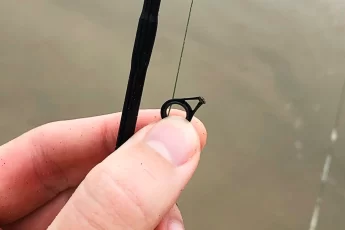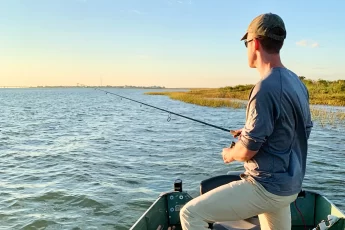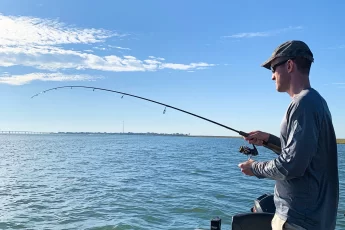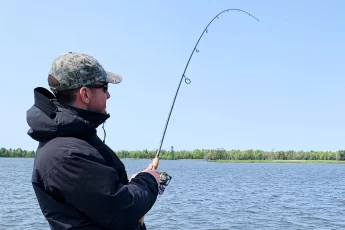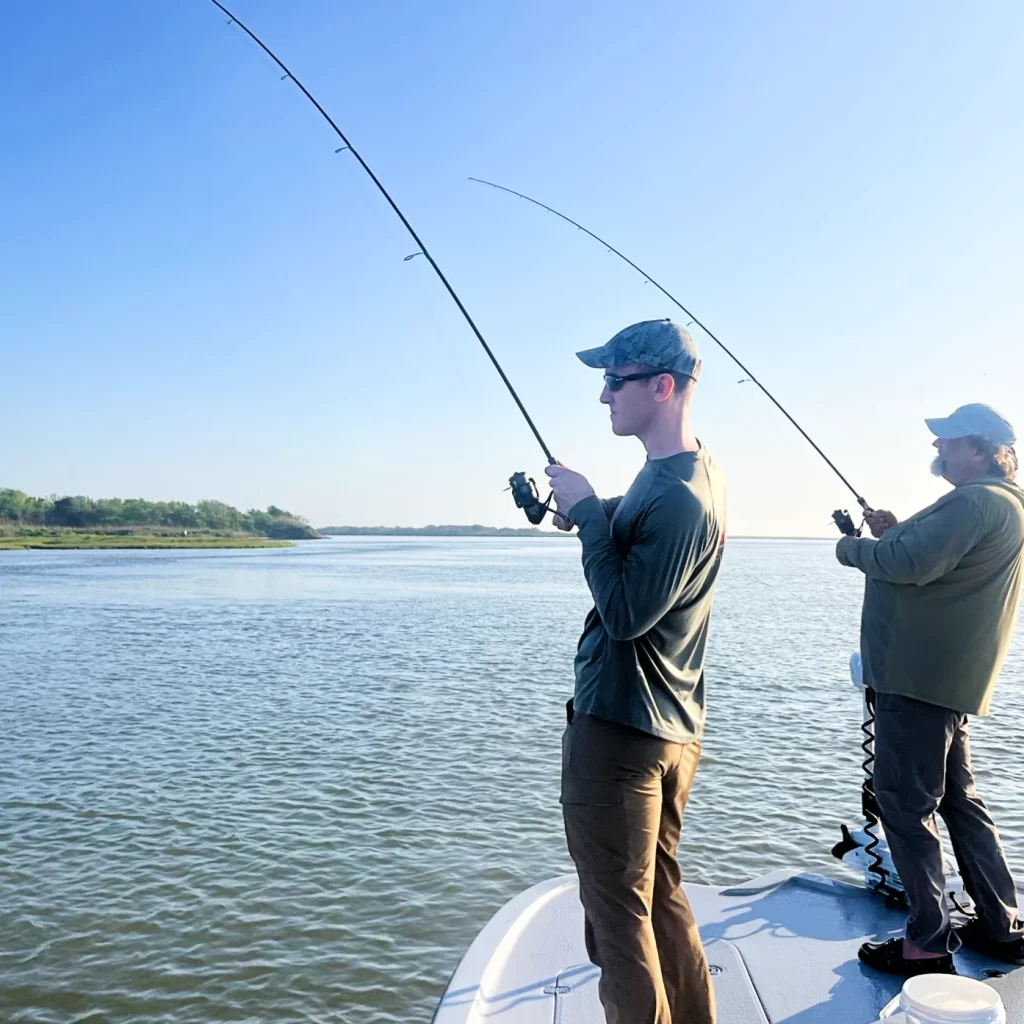
Welcome to our comprehensive guide on choosing a fishing rod. Whether you’re a seasoned pro or just dipping your toes into the waters of fishing, understanding the differences in fishing rods is key to a successful catch.
In this guide we cover everything from basic selection considerations like type, length, action, and power, to more nuanced aspects such as portability and affordability. We’ll also explore the different components that make up a fishing rod, offer insights on where to purchase them, and highlight popular brands in the market. Furthermore, we provide tailored recommendations for various types of rods including spinning, baitcasting, conventional, and surf, ensuring you’re well-equipped for any fishing scenario.
*Disclosure: I only recommend products I would use myself and all opinions expressed here are my own. This post may contain affiliate links that at no additional cost to you, I may earn a small commission.
Table of Contents
- Fishing Rod Selection Considerations
- Fishing Rod Components
- Where to buy Fishing Rods
- Popular Fishing Rod Brands
- General Rod Recommendations
- Conclusion
- Frequently Asked Questions
Fishing Rod Selection Considerations
When selecting the perfect fishing rod, the key considerations are rod type, length, action, power, portability, and affordability. The length of the rod is crucial as it affects casting distance and accuracy. Rod action, which refers to the flexibility of the rod and how it bends under pressure, plays a significant role in the sensitivity and the preferred fishing techniques for that rod action. Equally important is rod power, or rod backbone, which determines the rod’s resistance and suitability for different sizes of fish and fishing techniques. Portability can be important for anglers on the go, who may prefer a rod that is easy to transport and store. Lastly, affordability is a consideration because balancing quality with a budget is important to find each person’s best value for money. Each of these aspects contributes to the overall fishing experience, making it essential to choose a rod that aligns with your specific needs and preferences.
Fishing Rod Types
One of the most important considerations when selecting a fishing rod is deciding what type of reel you want the rod to pair with. Rods have different reel seats, guide sizes, and general ergonomics depending on the type of reel that get paired with it. The main rod and reel types are spinning, baitcasting, conventional and fly fishing setups along with subcategories like surf fishing, trolling, ice fishing, or travel rods.
Deciding between a spinning, casting, conventional, or specialty rods like fly rods or ice fishing rods hinges on your target species, fishing environment, and personal skill level. Spinning rods are ideal for beginners and live bait applications due to their ease of use, versatility, and suitability for lightweight lures and a variety of fish. Casting rods, offer greater accuracy and control making them a better choice for experienced anglers fishing with techniques that require repeated casting. Conventional rods are commonly designed for trolling, surf fishing, or deep sea fishing and heavy tackle. Lastly, fly fishing rods are specialized for fly fishing, where the technique and the fly lure’s presentation are crucial. Your choice should align with the type of fishing you intend to do, the species you aim to catch, and your comfort with the rod’s mechanics.
Spinning Rods
A spinning fishing rod is a versatile and user-friendly type of fishing rod, characterized by its spinning reel mounted underneath the rod, with guides (or eyes) facing downward. This design allows for better balance and less strain on the angler’s wrist, making it easier to use for extended periods. Anglers often pick a spinning rod for its ease of casting, especially with lighter baits and lures, and its suitability for a wide range of fishing techniques and environments, from freshwater lakes to inshore saltwater fishing. Its ease of use makes it an excellent choice for beginners, yet it remains a popular choice among experienced anglers for its precision and versatility in catching a variety of fish species. The spinning rod’s ability to handle diverse fishing situations and its user-friendly nature make it a staple in the angler’s arsenal.
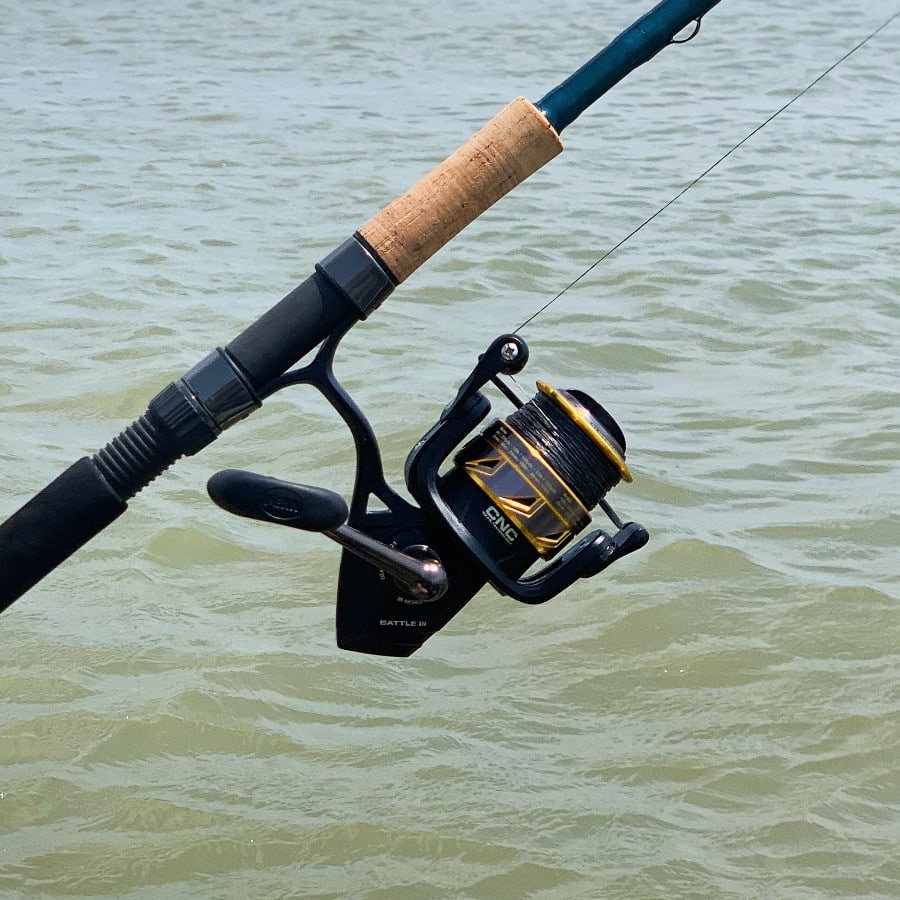
At Juran Adventures, we always have a selection of spinning rods in the boat. We prefer spinning rods for live-bait fishing applications, for the smallest baits, and for beginner anglers that are not comfortable with casting rods.
To identify a spinning rod at the store, it should have a straight handle and reel seat with comparatively larger line guides than a comparative baitcasting rod.
Check out our articles on the best beginner fishing rods and best bass spinning rods for some examples of great spinning rod options.
Baitcasting Rods
A baitcasting rod is a sophisticated tool in an angler’s arsenal, designed to work with a baitcasting reel, which sits atop the rod. This configuration allows the line to come off the reel more directly, offering greater control and accuracy, especially for casting at longer distances. Baitcasting rods are favored by experienced anglers anglers that require precise lure placement or fish with techniques that require frequent casts. They excel in handling heavier line and lures, making them ideal for bass fishing and other types of power fishing techniques. However, baitcasting setups demand a higher level of skill to use effectively, as they are prone to tangling or ‘backlash’ if not handled correctly. For anglers looking to upgrade their technique, target bigger fish, or achieve greater accuracy and control in their casting, a baitcasting rod is an excellent choice.
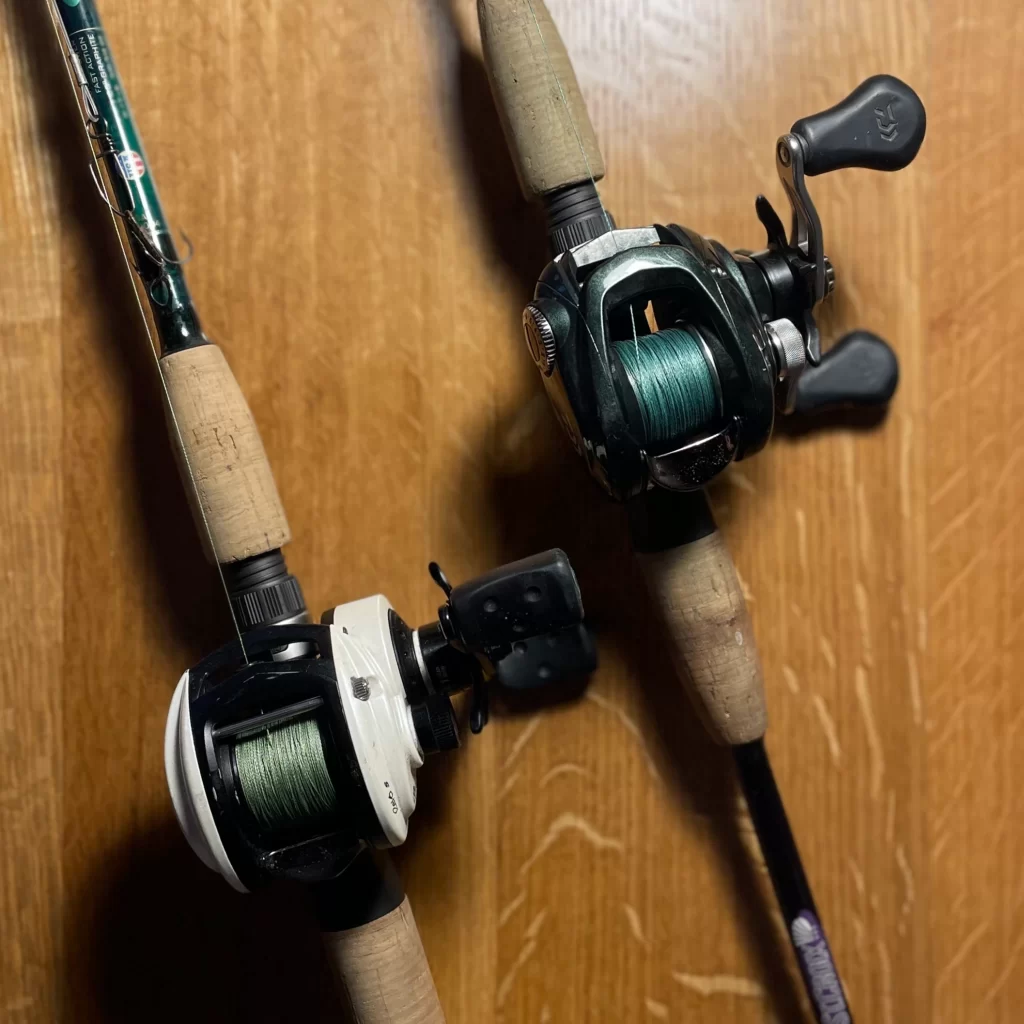
Baitcasting rod setups are our preferred fishing rods to fish artificial baits for largemouth bass, smallmouth bass, and pike in freshwater and speckled trout, flounder, and redfish inshore. Baitcasting setups offer unrivaled casting comfort and accuracy. The angler is able to ‘thumb’ the spool during the cast to slow down the bait and land it in the perfect spot. Spinning setups are unable to do this; once you cast a spinning rod, the bait will go on whatever trajectory it started on.
Check out our article on the best baitcasting rods for bass for great options.
Conventional Rods
A conventional rod, often used for offshore, trolling, or surf fishing, is designed to work with a conventional reel, which is mounted on top of the rod. These rods are built to handle large quantities of heavy line and large fish, making them ideal for trolling, bottom fishing, and big game fishing. The strength and durability of conventional rods allow anglers to target large species like tuna, marlin, and sharks. They are typically stiffer than spinning or baitcasting rods, providing better leverage and power for fighting and reeling in large, strong fish. The reel’s design also enables more efficient line management, especially when dealing with deep water and strong currents. While conventional rods are less suitable for casting due to their heavy build and the reel’s design, they excel in situations where brute strength and endurance are required. Anglers who engage in offshore fishing or who are after the challenge of large game fish often opt for conventional rods for their robust performance in demanding conditions.
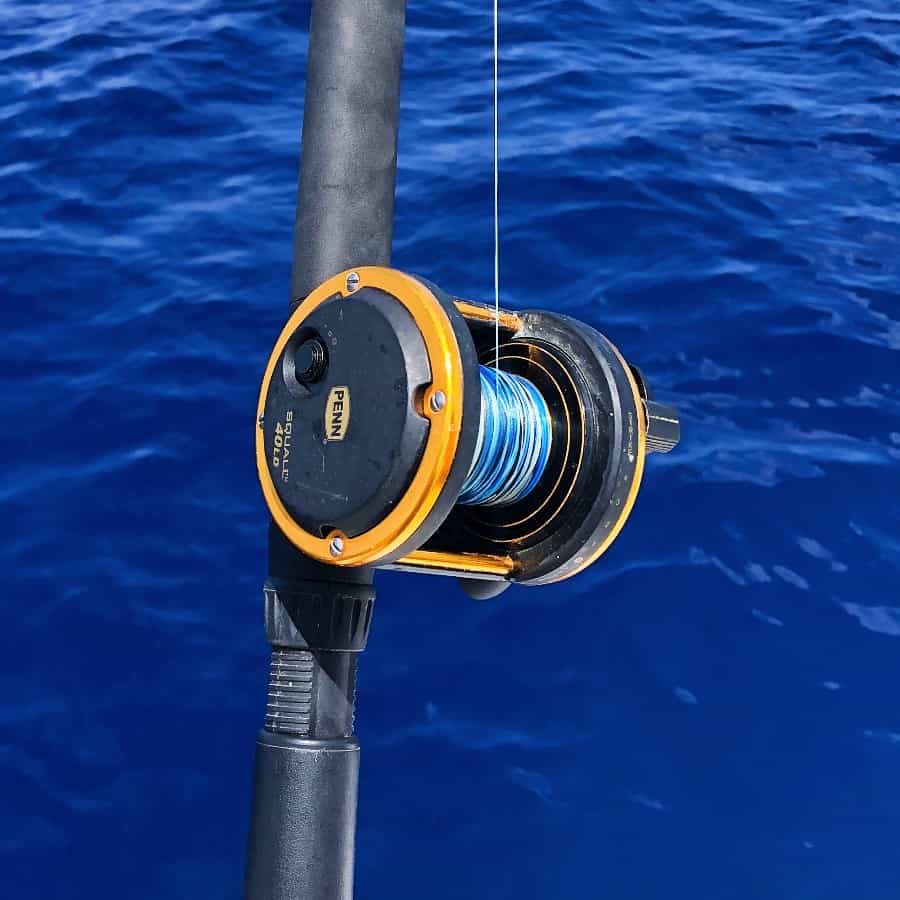
We are also fans of conventional reel setups for surf fishing where line capacity and reel drag ratings can be important factors. Conventional reels generally have higher capacities than comparative spinning setups.
Our articles on the best surf fishing rods and best trolling rods have some excellent conventional rod options.
Surf Fishing Rods
A surf fishing rod is a specialized type of fishing rod designed for casting baits or lures from the shore into the surf or along coastal areas. These rods are typically longer, ranging from 10 to 15 feet, to facilitate long-distance casting, allowing anglers to reach deeper waters where fish are likely to be found. Surf rods are built to handle heavy baits and sinkers, and they are capable of withstanding the corrosive saltwater environment. They often feature sturdy, durable construction and come in spinning and conventional versions, depending on the angler’s preference and the fishing conditions. Anglers choose surf fishing rods for their ability to tackle the unique challenges of shore-based fishing, including casting over large distances, battling strong ocean currents, and reeling in potentially large, powerful fish. Whether targeting species like striped bass, redfish, or bluefish, surf fishing rods offer the strength and reach needed for successful shore-based angling.
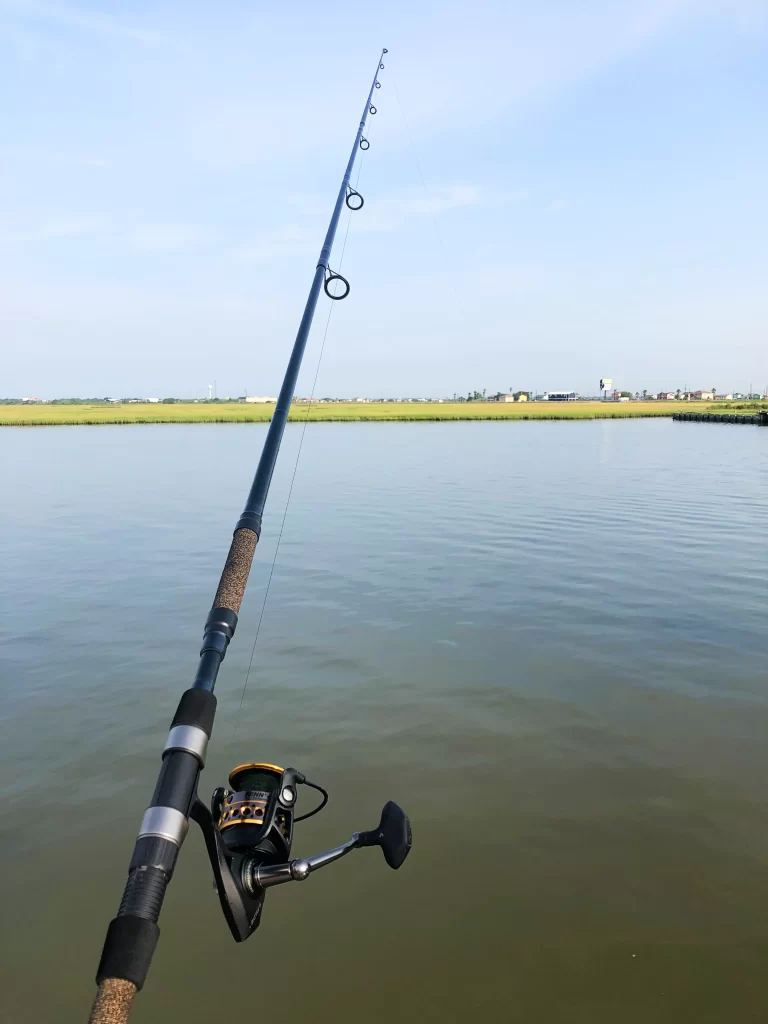
Check out our articles on the best surf fishing rods and the best pier fishing rods for some great choices like the St. Croix Triumph Surf.
Trolling Rods
Trolling rods are specifically designed for the fishing technique known as trolling, where lures or bait are drawn through the water behind a moving boat. These rods are robust and typically shorter than other types of fishing rods, with lengths usually ranging between 5 to 8 feet. This shorter length provides greater strength and leverage, essential for handling the high tension created by trolling at boat speed and for fighting large fish. Trolling rods are built to withstand the constant pull and heavy loads, often featuring a thicker and more durable construction compared to other rod types. Many trolling rods are made of fiberglass instead of carbon-graphite because of the comparative durability and reduced need for sensitivity.
Anglers pick trolling rods to target a wide range of fish from tuna and marlin to walleye and salmon. Smaller fish like walleye require lighter setups, where trolling rods setup to target marlin may be some of the heaviest-duty rods on the market.
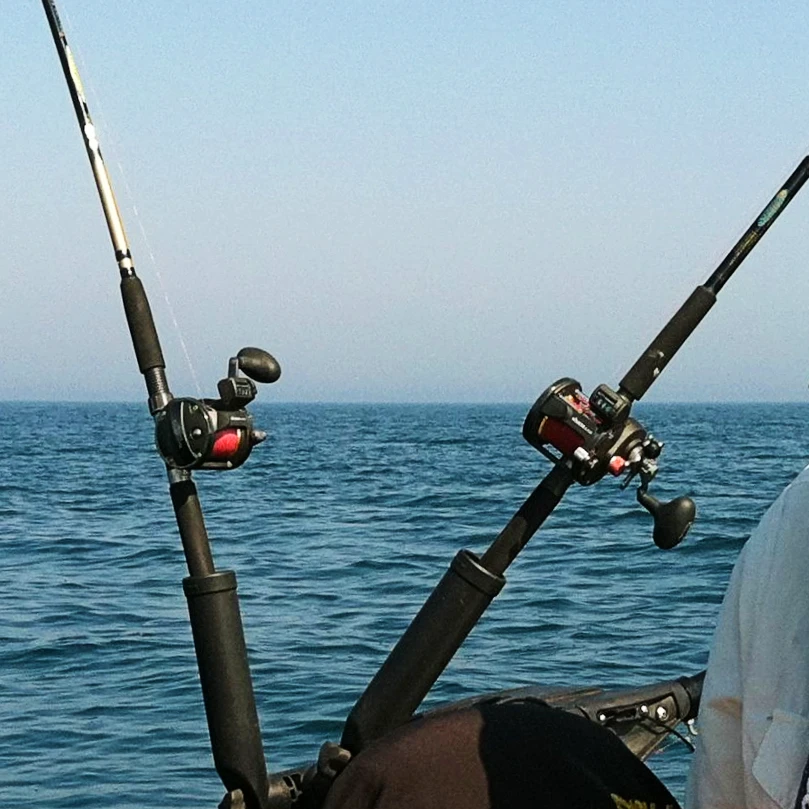
Check out our article on the best trolling rods for great trolling options.
Ice Fishing Rods
Ice fishing rods are specialized tools designed for the unique conditions of fishing through a hole in the ice. These rods are significantly shorter than typical fishing rods, usually ranging from 24 to 36 inches in length. The compact size is essential for the close-quarters environment of ice fishing, allowing for better maneuverability and control inside an ice shelter or in the open on a frozen lake. Despite their small size, ice fishing rods are surprisingly strong and sensitive, designed to detect the subtle bites of fish in cold water and to manage the fight with fish in a confined space.
Anglers choose ice fishing rods for their tailored functionality in the icy environment. These rods often feature a lighter power and a fast action, which is ideal for targeting species like panfish, trout, and walleye under the ice. The shorter length allows for more precise jigging movements, a common technique in ice fishing. Additionally, the handles are designed to be comfortable to use with gloves or mittens, considering the freezing conditions. Ice fishing rods are indispensable for anglers who pursue the unique and rewarding experience of fishing in the winter, providing the necessary tools to effectively fish in a challenging and cold environment.
Ice fishing rods are almost always paired with spinning reels.
Fly Fishing Rods
Fly fishing rods are distinctively designed for the skillful and traditional art of fly fishing. These rods are typically longer and more flexible, ranging from 6 to 10 feet, to facilitate the unique technique of casting lightweight flies using the weight of the line. They are favored for their precision in presenting flies on or just below the water’s surface, ideal for catching species like trout and salmon in freshwater and certain species in saltwater. Anglers choose fly fishing rods for their ability to provide a highly engaging and direct connection with the fish, offering a rewarding experience that emphasizes the angler’s skill in mastering the unique casting technique required for fly fishing.
Travel Fishing Rods
Travel fishing rods are designed for convenience and portability, catering to anglers who are on the move. These rods are typically constructed to be easily disassembled into shorter sections or are telescopic, allowing them to compact down to a manageable size for transport in luggage, backpacks, or even under a car seat. Despite their collapsible nature, travel rods do not have to compromise on strength and functionality, and often matching the performance of standard one-piece rods.
Anglers choose travel fishing rods for their versatility and ease of transport, making them ideal for hiking, camping trips, or any situation where space is limited. They come in various styles to suit different fishing techniques, including spinning, casting, and fly fishing. While they might lack the sensitivity or specific action of specialized one-piece rods, travel rods offer a fantastic balance of convenience and capability, ensuring anglers don’t miss an opportunity to fish in new and exciting locations.
Rod Length
It’s important to match the rod length to your fishing environment and target species. Longer rods provide more casting distance but can be cumbersome in tight spaces, while shorter rods offer more control and power for close combat but limit your casting range. If picking one fishing rod to do almost everything, I recommend a spinning or casting rod around 7 feet long. This length provides a perfect balance of casting distance and angler comfort. For fishing techniques that do not require long casts, like vertical jigging over the side of a boat, rods between 6′ and 6’6″ are perfect. For baitcasting rods that need repeated, longer casts, I like 7′ to 7’6″ rods.
For surf fishing, where casting distances is generally the most important factor, anglers size up to rods between 10 and 15 feet long to maximize casting distance.
Rod Action
Rod action, which refers to where and how much a rod bends when pressure is applied, is a key aspect to consider when choosing a fishing rod. Rods actions range from extra-fast all the way to slow.
- Fast Action Rods: These rods bend mostly near the tip, offering greater sensitivity and power for setting the hook. They are ideal for fishing techniques requiring sensitivity and quick hook sets, such as when fishing with jigs and worms. Fast action rods are also preferred for situations where a strong hook set is needed, particularly in deep water or when targeting large fish.
- Moderate Action Rods: Offering a balance between sensitivity and flexibility, these rods bend in the top half. This action is versatile, making them suitable for a variety of lures and fishing techniques. They are great for casting distance because they feel a bit whippier than fast action rods. Many anglers prefer moderate action rods for fishing with crankbaits.
- Slow Action Rods: Slow action rods are not that common anymore. They bend throughout their entire length. We generally don’t recommend slow action rods.
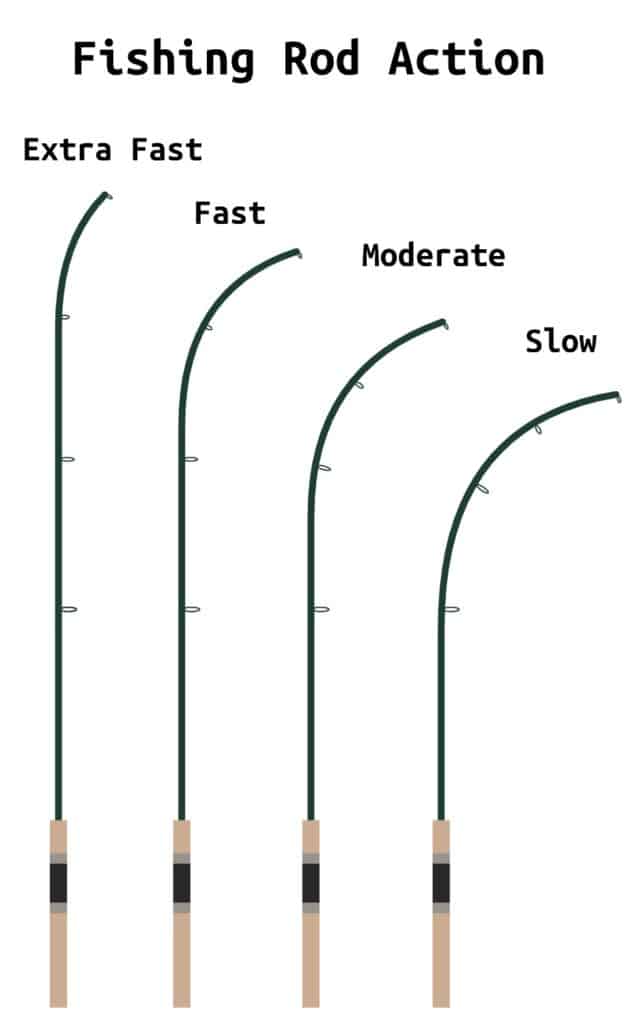
Choosing the right rod action depends on your specific fishing technique, the type of lure or bait you intend to use, and the species of fish you’re targeting. Matching the rod action to your fishing style not only enhances your overall experience but also improves your chances of a successful catch.
When in doubt, we recommend a fast action as the ideal rod action for MOST fishing techniques because it provides a great balance of castability and sensitivity.
Rod Power
Rod power, or the rod’s resistance to bending, is a critical aspect to consider when selecting a fishing rod. It’s often categorized into ultra-light, light, medium, medium-heavy, heavy, and ultra-heavy.
- Ultra-light and Light Power Rods: These are perfect for smaller species like panfish and trout. They provide excellent sensitivity and are ideal for casting light lures and baits.
- Medium and Medium-Heavy Power Rods: These are versatile choices suitable for a wide range of fishing conditions. They work well for larger freshwater species like bass and walleye, as well as for inshore saltwater fishing.
- Heavy and Ultra-heavy Power Rods: Designed for big game fishing, these rods are the go-to for targeting large saltwater species like tuna and marlin. They provide the necessary strength and backbone for handling heavy lures and fighting powerful fish. Some niche bass fishing techniques also utilize heavy power rods.
The choice of rod power should align with the type of fishing you plan to do, the size of the fish you’re targeting, and the weight of the lures or bait you’ll be using. A well-chosen rod power enhances your control and effectiveness, leading to a more successful and enjoyable fishing experience.
Portability
When considering portability in fishing rods, it’s essential to think about how easy and convenient it is to transport and store the rod, especially if you’re an angler who travels or has limited storage space. Rod portability is primarily determined by the rod’s design and construction.
- Telescopic Rods: These rods can collapse down to a fraction of their full length, making them ideal for backpackers, hikers, or travelers. They offer the convenience of easy packing without sacrificing too much on performance.
- Two-Piece or Multi-Piece Rods: These rods can be broken down into two or more sections. While they are not as compact as telescopic rods, they still offer a significant advantage in terms of transport and storage compared to one-piece rods. They strike a balance between portability and maintaining the integrity of the rod’s action and power.
- One-Piece Rods: These offer the best performance in terms of action and sensitivity but are the least portable. They are ideal for anglers who fish locally or have ample space for transport and storage.
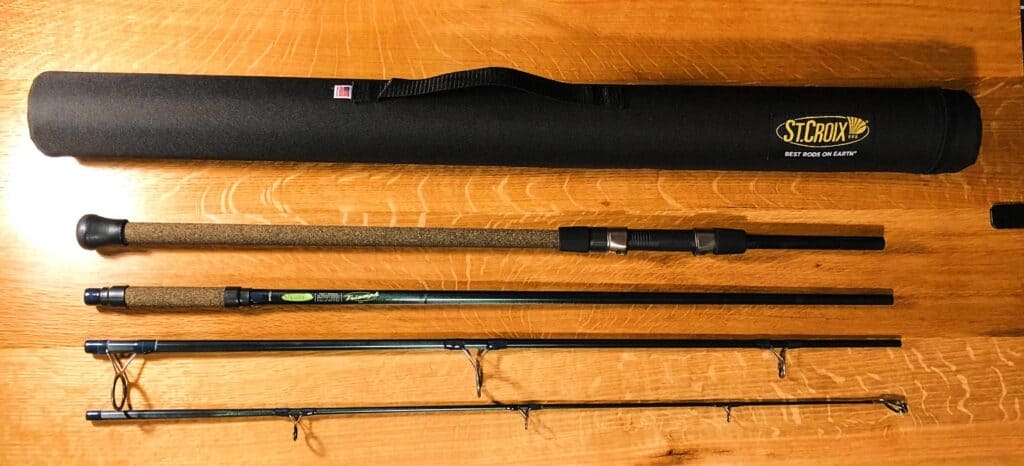
Selecting a rod based on portability depends on your specific needs as an angler. If you frequently travel or have limited space, a telescopic or multi-piece rod may be the best choice. However, if portability is not a major concern, a one-piece rod could be the better option for optimal fishing performance. For additional reading on the importance of proper storage and transportation, check out our ultimate guide on fishing rod care and maintenance.
Affordability
Affordability is a key consideration when selecting a fishing rod, particularly for beginners or those on a budget. The cost of a fishing rod can vary widely, influenced by factors like material, brand, craftsmanship, and technology.
- Entry-Level Rods: These rods are typically made from more affordable materials like basic fiberglass or lower-grade graphite. They offer good functionality for casual or beginner anglers and are often the most budget-friendly option. However, they may lack the sensitivity and durability of higher-end rods.
- Mid-Range Rods: Offering a balance between cost and quality, mid-range rods usually feature better construction and materials than entry-level options. They provide improved performance and durability, suitable for anglers who fish regularly but don’t require professional-grade gear.
- High-End Rods: These rods are made with top-quality materials and advanced technology, offering the best performance, sensitivity, and durability. They are ideal for serious anglers who demand the best equipment. However, they come at a significantly higher price point.
Choosing a rod within your budget while considering your fishing needs and frequency is important. An affordable rod that meets your specific requirements can provide a great fishing experience without breaking the bank. It’s also worth considering that investing a bit more in a mid-range rod can offer better value in the long run, especially for those who fish regularly.
Fishing Rod Components
Understanding the various components of a fishing rod is essential for both beginners and experienced anglers. A fishing rod is composed of several key parts, each playing a crucial role in the rod’s function and performance. These components include the rod blank, guides, handle (or grip), the reel seat, and the tip. The rod blank is the backbone, typically made of graphite, fiberglass, or a composite of both, determining the rod’s overall strength, sensitivity, and action. Guides, evenly spaced along the blank, facilitate smooth line movement. The handle, often made from cork or EVA foam, ensures a comfortable and secure grip, while the reel seat holds the reel in place. Lastly, the tip is the most delicate part, offering sensitivity to detect even the slightest nibbles. Together, these elements form the anatomy of a fishing rod, each contributing to its effectiveness in casting, retrieving, and landing fish.
Rod Blank
The rod blank is the structural backbone of a fishing rod, fundamentally defining its overall performance and characteristics. Typically made from materials like graphite, fiberglass, or a composite of both, the rod blank determines the rod’s strength, flexibility, sensitivity, and action. Graphite blanks are known for their comparative strength for their weight and superior sensitivity making them ideal for detecting subtle bites. Fiberglass blanks offer more flexibility and durability, and are often more affordable, although they tend to be heavier. Composite blanks blend the best of both materials, offering a balance between sensitivity and flexibility. The construction of the rod blank affects how it will bend under pressure (action) and its resistance to bending (power), which are crucial for different fishing styles and target species. A well-constructed rod blank ensures the angler has the right tool for effectively casting, feeling the bite, and fighting the fish.
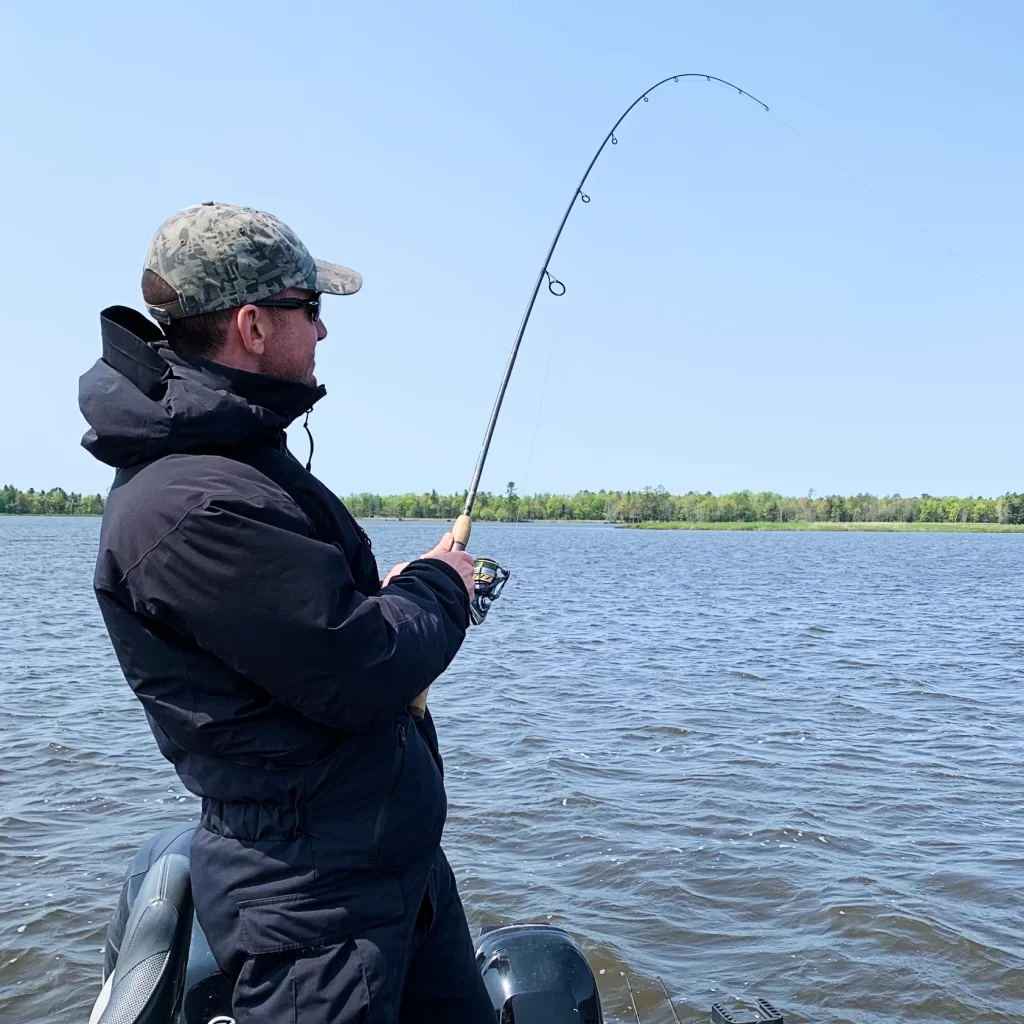
We generally recommend graphite blanks for fishing techniques that require sensitivity and angler comfort. We like fiberglass blanks for fishing techniques that require utmost rod strength like trolling or heavy-duty deep-sea fishing.
Check out our deep dive article on fishing rod blanks for even more information.
Rod Guides
Rod guides are the small rings, usually made of metal frames with ceramic or metal inserts, that are spaced along the length of the rod blank. They serve to direct and distribute the fishing line evenly from the reel to the rod tip, ensuring smooth and efficient casting and retrieval. The quality and placement of guides influence the rod’s sensitivity, casting distance, and accuracy. Higher-end rods often feature more guides, which helps reduce friction, protect the line from wear, and maintain better control over the line’s movement, especially during a fish fight. The number, size, and type of guides vary depending on the rod’s design and intended use, with each configuration aimed at optimizing the rod’s performance for specific fishing techniques and conditions. Properly functioning rod guides are essential for a seamless fishing experience, minimizing line tangling and maximizing the angler’s control and sensitivity.
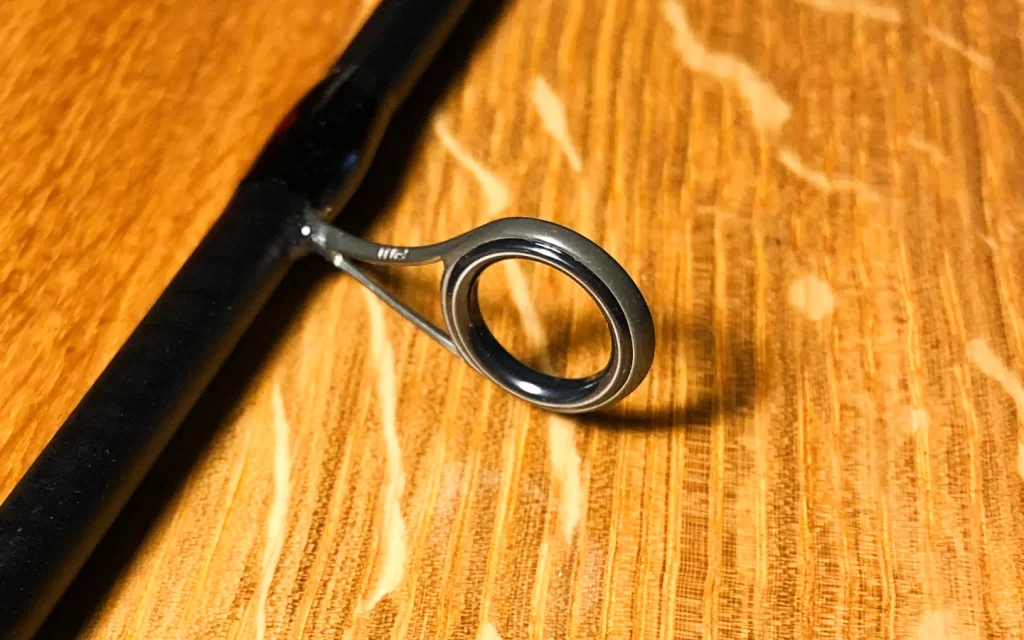
Rod guides are generally larger in diameter on spinning rods when compared to the slim-profile guides on baitcasting rods.
Check out our deep dive article on fishing rod guides for much more detailed information!
Rod Handle
The rod handle, or grip, is a key ergonomic component of a fishing rod, designed for comfort and control during long hours of fishing. Typically made from materials like cork, EVA foam, or rubber, the handle determines the angler’s level of grip and comfort. Cork handles are popular for their lightweight, durable nature and comfortable grip, providing a good balance between sensitivity and cushioning. EVA foam handles are known for their durability, resistance to elements, and affordability, though they might offer slightly less sensitivity than cork. The design of the handle can vary, with options like split grips for lighter weight and increased sensitivity, or full grips for better leverage and control, especially in heavy-duty fishing scenarios.
The length and shape of the handle also play a significant role, influencing the casting technique and the type of fishing. Longer handles are ideal for casting with two hands or for techniques requiring long casts, while shorter handles are better suited for one-handed casts or precise, short-distance casting. The right handle enhances the overall fishing experience, providing the necessary comfort and control, whether battling a large fish or casting for hours on end.
Reel Seat
The reel seat is the part of the rod designed to securely hold the reel in place. Located where the handle meets the rod blank, the reel seat is a critical point of connection between the angler and the rod. It typically consists of a threaded locking mechanism that ensures the reel stays firmly attached to the rod, even during the rigors of casting, retrieving, and battling fish. The quality and design of the reel seat are important for maintaining stability and alignment of the reel, which in turn affects casting accuracy and the overall handling of the rod.
Reel seats are made from various materials, including graphite, aluminum, or a combination, chosen for their strength, durability, and resistance to corrosion, especially in saltwater environments. The design of the reel seat also varies, with some featuring ergonomic shapes or cushioning for added comfort and grip. The size and type of the reel seat must correspond to the type of reel being used – spinning or casting – and the size of the rod. A well-designed reel seat not only secures the reel effectively but also contributes to the balance and feel of the rod, enhancing the angler’s control and comfort during fishing.
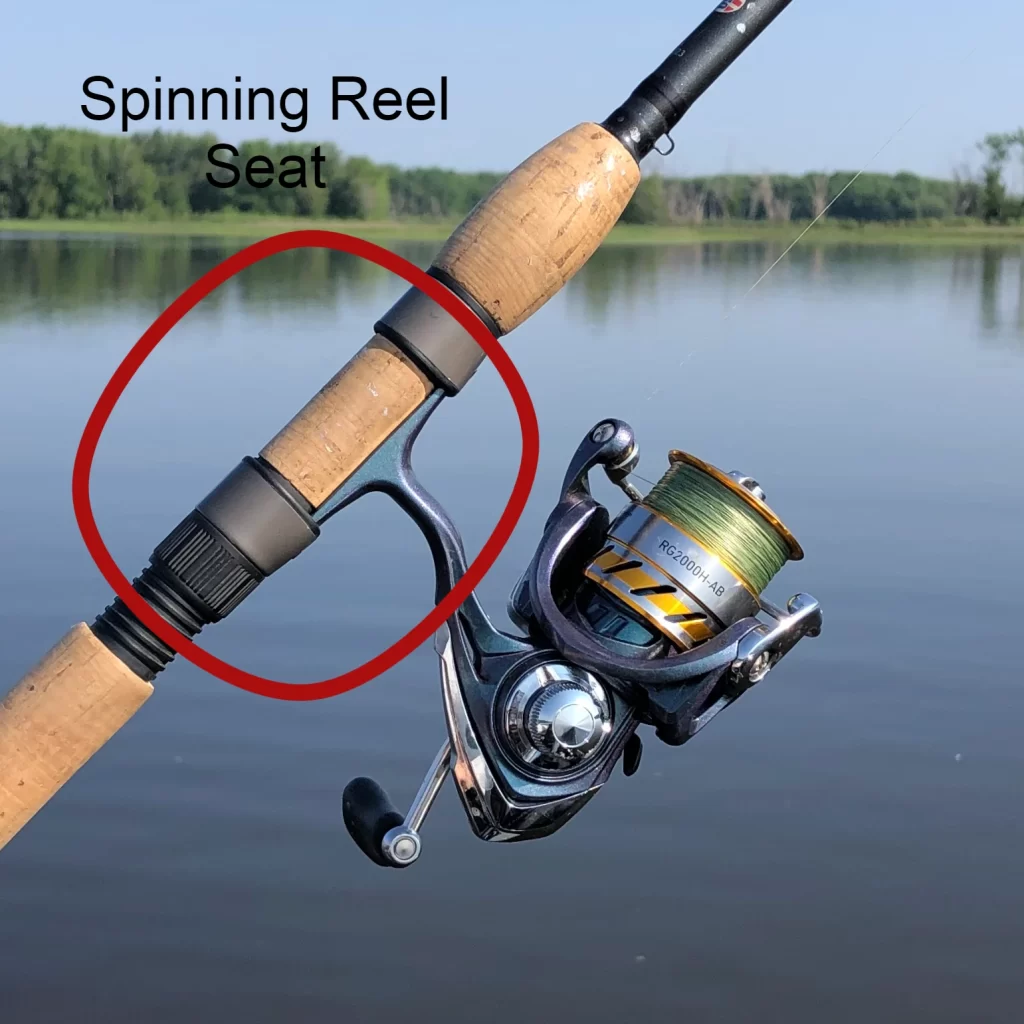
Rod Tip
The rod tip is crucial for sensitivity and responsiveness. It’s the thinnest and most flexible section, designed to detect the slightest nibbles or changes in the line’s tension. The rod tip’s sensitivity allows anglers to feel when a fish takes the bait, which is essential for timely hook sets. It also plays a significant role in casting, as the flexibility of the tip aids in building up and releasing the energy needed to propel the lure or bait.
The action of the rod, which describes how and where the rod bends, is largely influenced by the tip’s characteristics. Fast action rods have stiffer tips, while slow action rods feature more flexible tips.
Given its delicate nature, the rod tip is often the most vulnerable part of the rod to damage. Careful handling and storage are important to prevent breakage. A well-designed and maintained rod tip enhances the overall effectiveness of the rod, providing the sensitivity needed for successful fishing, especially in techniques requiring finesse and precision.
Where to Buy Fishing Rods
When looking to purchase a fishing rod, there are several options available, each catering to different preferences and needs. Local tackle shops are a great choice, offering personalized advice and the opportunity to handle the rods before buying. Big-box sporting goods stores typically have a wide selection of brands and models at various price points, making them convenient for a broad range of customers. For those who prefer online shopping, numerous websites and online retailers offer extensive selections and often provide customer reviews, which can be helpful in making a decision. Additionally, buying online often allows for price comparisons and finding deals. Whether buying in-store or online, it’s important to consider factors like warranty, return policy, and customer service when choosing where to purchase your fishing rod.
Shipping can be hit or miss with online retailers if they don’t package the rods well. I’ve ordered St. Croix rods directly from their website that came in robust cardboard tubes that more than protected the rods. I’ve also ordered rods from competitors that came in a flimsy cardboard box with the rod tip broken off. Fortunately with online retailers, they will generally take a return and provide an intact rod if there was any shipping damage.
Popular Fishing Rod Brands
When it comes to fishing rods, several popular brands are renowned for their quality, innovation, and wide range of products catering to different fishing styles and preferences. In no particular order:
- Shimano: A leader in the fishing industry, Shimano is known for producing high-quality rods and reels, offering exceptional performance and durability.
- Daiwa: Daiwa is another top brand that stands out for its innovative technology and wide array of fishing gear, suitable for both beginners and professional anglers.
- Penn: Specializing in saltwater fishing, Penn is famous for its robust and high-performing rods..
- Ugly Stik by Shakespeare: Renowned for its virtually indestructible rods, Ugly Stik offers excellent value and durability, making it a favorite among many anglers.
- St. Croix: This brand is known for its handcrafted fishing rods, offering superior quality and performance, particularly popular with bass and fly fishermen.
- G. Loomis: Highly regarded in the fishing community, G. Loomis is known for its high-end rods, emphasizing sensitivity and strength.
- Abu Garcia: A well-respected brand offering a range of fishing gear, Abu Garcia is particularly noted for its balance of quality and affordability in its rods.
- Berkley: Berkley offers a variety of rods that are popular for their performance, affordability and reliability, especially among freshwater anglers.
Each of these brands has its unique strengths and specialties, catering to different fishing environments and styles. Whether you’re a beginner or a seasoned angler, choosing a rod from a reputable brand can significantly enhance your fishing experience.
I personally grew up fishing summers near Park Falls, Wisconsin, St. Croix’s US headquarters. Much of the Juran clan is partial to the high quality rods that St. Croix makes. We’ve since branched out to many other popular fishing brands and they all have great offerings for certain applications.
Recommended Fishing Rods
If you’re looking to have one rod of some of the popular rod types, here are my recommendations considering the balance of length, action, power, and price point:
Spinning Rod
- Length: 7 feet
- Action: Fast
- Power: Medium
- Price Point: Around $100 – $150
- Why Choose This: A 7-foot medium power rod with a fast action is incredibly versatile, suitable for a variety of freshwater and light saltwater fishing. It offers a good balance between casting distance, accuracy, and sensitivity. This price range usually provides a quality rod that’s durable and sensitive without breaking the bank.
Baitcasting Rod
- Length: 7 to 7’6″ feet
- Action: Fast
- Power: Medium
- Price Point: Around $150 – $200
- Why Choose This: A baitcasting rod in this range is ideal for experienced anglers seeking precision and control. The medium power with a fast action is perfect for bass, redfish, and speckled trout fishing and other techniques requiring frequent, accurate casting. This price point ensures a high-quality rod that can handle a variety of lures and fish sizes.
Conventional Rod
- Length: 6 to 7 feet
- Action: Moderate to Fast
- Power: Heavy
- Price Point: Around $150 – $250
- Why Choose This: For conventional rods, which are typically used for offshore and big game fishing, a 6 to 7-foot length with heavy power and moderate to fast action is ideal. It provides the necessary strength and leverage for large fish while maintaining good sensitivity. This price range offers robust and durable rods suitable for challenging marine environments.
Surf Rod
- Length: 10 to 12 feet
- Action: Moderate to Fast
- Power: Medium-Heavy
- Price Point: Around $100 – $200
- Why Choose This: A longer surf rod is essential for casting long distances from the shore. A 10 to 12-foot rod with medium-heavy power and moderate to fast action allows for good casting range while being capable of handling larger fish and heavy baits. This price bracket offers a range of durable and high-performance rods suitable for surf fishing. We also recommend looking at travel versions of surf rods to improve portability.
Each of these rods is a great all-rounder within its category, providing a good balance of the necessary features at a reasonable price point. These recommendations are suited for anglers who want a reliable and versatile option for each rod type, ensuring a rewarding fishing experience in various environments and conditions.
Conclusion
Whew! That’s a ton of information. Let’s sum things up. Pick a fishing rod tailored to your ideal type of fishing. This will include considerations on rod type, length, action, power, portability, and affordability. Below is a quick table comparing the most popular rod types and their ideal usage.
Fishing Rod Comparison Chart
| Type of Rod | Features | Ideal Usage | Price Range |
|---|---|---|---|
| Spinning Rod | Easy to use, versatile, good for beginners | Freshwater lakes, inshore saltwater | $20 – $200 |
| Baitcasting Rod | Greater control, for experienced anglers | Bass fishing, frequent casting | $50 – $300 |
| Conventional Rod | Heavy-duty, for large fish | Offshore, trolling, surf fishing | $60 – $500 |
| Fly Fishing Rod | Long, flexible, for casting flies | Trout, salmon in rivers and streams | $100 – $800 |
| Ice Fishing Rod | Short, strong, for cold conditions | Ice fishing in frozen lakes | $15 – $150 |
| Travel Rod | Portable, easy to transport | Travel, hiking, camping | $30 – $250 |
Check out our related rod articles for great options in some of the most popular fishing categories:
- Best Bass Baitcasting Rods
- Best Bass Spinning Rods
- Best Beginner Fishing Rods
- Best Inshore Rods
- Best Saltwater Fishing Rods
- Best Surf Fishing Rods
- Best Trolling Rods
Frequently Asked Questions
- What is the best type of fishing rod for beginners?
- Spinning rods are best for beginners. They are user-friendly, versatile, and excellent for a wide range of fishing environments and techniques, especially with lighter lures and baits.
- How do I choose the right length for my fishing rod?
- The right length fishing rod depends on your fishing environment and style. Shorter rods (under 6 feet) offer more control for close-quarters fishing, medium-length rods (6 to 8 feet) are versatile for various conditions, and longer rods (over 8 feet) are great for casting long distances, like in surf fishing.
- What does ‘rod action’ mean and why is it important?
- Rod action refers to where the rod flexes along the blank. Fast action rods bend near the tip, moderate action rods bend near the middle, and slow action rods bend toward the base. This affects casting distance, sensitivity, and the type of fish you’re targeting.
- Can I use the same rod for freshwater and saltwater fishing?
- Fishing rods can all be used for both freshwater and saltwater. That said, saltwater fishing often requires rods with more corrosion-resistant materials and construction to handle larger, stronger fish. Freshwater rods may tend to rust and corrode quickly in saltwater environments
- Why are some rods more expensive than others?
- The price of rods varies based on materials, construction quality, brand reputation, and specific features. Higher-priced rods typically offer better performance, durability, and sensitivity.
- How should I store my fishing rod to ensure its longevity?
- Store your rod horizontally or in a rod rack, away from direct sunlight and high humidity. Ensure it’s clean and dry before storing, and use a rod cover for extra protection.
- Is it worth buying a travel fishing rod?
- If you frequently travel or have limited space, a travel fishing rod is a great investment. These rods are designed for easy transport without significantly compromising on performance.
- What maintenance does a fishing rod require?
- Regular maintenance includes cleaning the rod with fresh water after use, especially in saltwater conditions, checking for damage, ensuring the guides are smooth and intact, and occasionally lubricating the reel seat.
- Can I replace components on my fishing rod?
- Yes, components like guides, tips, reel seats, and handles can often be replaced or upgraded. However, it’s important to ensure compatibility with the rod’s specifications and seek professional assistance if needed.
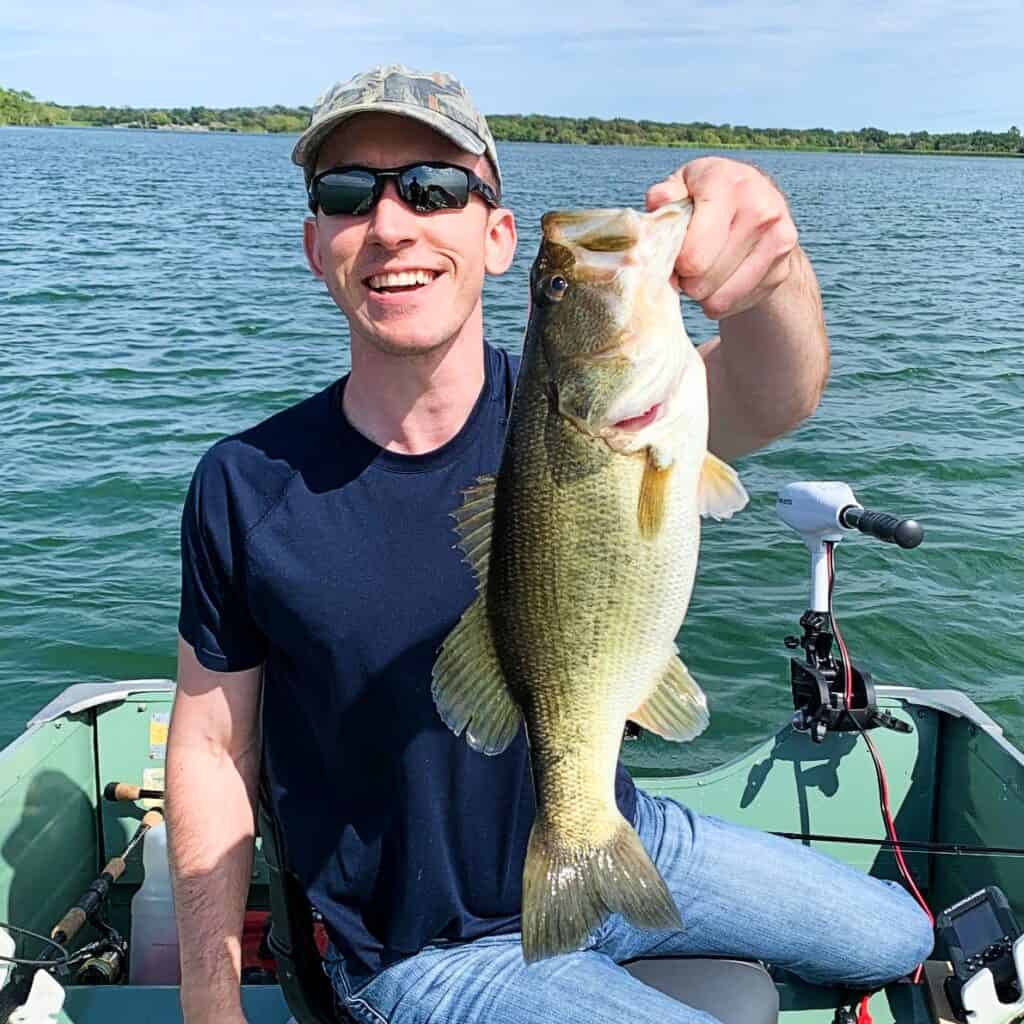
Written By: Andrew Juran
Andrew is a seasoned angler with over 25 years of experience fishing across the United States. He has caught hundreds of fish using various techniques and mentored many in the art of fishing. An advocate for sustainable fishing, Andrew is an active member of the Coastal Conservation Association, an organization committed to marine conservation.
For frequent fishing tips, behind-the-scenes looks, and real-time catches, connect with Andrew on Instagram


